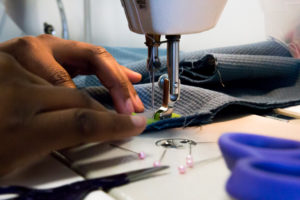
The glamorous world of fashion consumes our computer screens during Fashion Week, on the glossy pages of magazines and on life-sized posters in shopping malls and on billboards. Ever since I was a 13 year old watching “America’s Next Top Model,” I dreamed of being a photographer in the fashion industry. Millions of young teenagers share this dream of making it big in fashion but don’t know about all the dynamic jobs offered in that sought-after realm. Below are 10 possible careers in the fashion industry for the aspiring fashionista to look in to.
1. Visual merchandiser.
A visual merchandiser controls how merchandise looks throughout a store, how customers interact with the products and how they flow in a store layout. These merchandisers create window displays, in-store signage and even dress mannequins in head-to-toe looks to show customers a real-life application of their products.
2. Designer.
A fashion designer creates the ideas and sketches behind pieces of clothing and sews sample products. The higher up you get in the fashion world, the more jobs get delegated to the people assisting the designer such as seamstresses, pattern designers/makers and fashion illustrators.
3. Wardrobe stylist.
Styling by itself is not something you can get a degree in. It’s a culmination of communication, networking skills, a killer sense of style and an ability to put together a look. You have to be a people-person to know what a customer wants and what would look best on them. Whether it’s personal styling for a socialite or styling for a photo shoot or movie set, a wardrobe stylist should always be prepared and have options.
4. Fashion journalist.
Want my job? Obviously you can’t have it, but if you want to write about the world of fashion then fashion journalism may be your route. Being a fashion journalist means you have to constantly stay up-to-date with the fashion world as well as be an excellent writer. The world of fashion journalism is getting tough to break into as fashion blogging is becoming the quickest way to get fashion news. Why not beat those big names to the punch by starting your own blog to get your fashion insight out there or write for other bloggers. The more by-lines with your name on them the better. A great way to get your foot in the door is to contribute to the SCAD Connector Style section.
5. Editor.
A fashion editor for a magazine or newspaper is in charge of the contributing journalists who write articles about fashion trends and current events in the design realm. They also go to fashion weeks, trend presentations, photo shoots and help plan editorial photo shoots. Editors also create, cultivate and maintain relationships with brands and designers.
6. Fashion marketing/merchandising.
The business side of fashion begins here. Merchandisers and marketers learn about brands and create strategies to boost sales. Buyers locate products and negotiate deals to purchase products for their stores or websites.
7. Public relations.
A career in public relations is all about being the eyes, ears and voice between a brand and the public. Sales in the fashion world can plummet if a designer or brand is hit with a bad public image. It’s their job to keep the client’s work in the best light possible through media strategies, press events and more strategies.
8. Model.
If you have the right look and know how to work your best features, then modeling may be the career for you. However, it’s a hard journey to try and land a contract with an agency. Most models start out with local agencies, often known as “mother agencies,” that work with fresh models to build up their portfolio, skill set and look through local work before moving on to a higher-level agency. Atlanta is home to quite a few mother agencies that are underneath higher-level agencies in New York, Chicago and Los Angeles such as Click and Factor Women. There are also smaller agencies like Salt Model & Talent and Ursula Wiedmann Models.
9. Photographer.
Photography is an essential component for any thriving fashion business. Photographs are used in ad campaigns, lookbooks, website images and stores. A photographer’s job is one of many in the process to make a brand’s product look enticing for consumers. A freelance photographer is usually hired through an agency and should have an excellent portfolio book. An in-house photographer, one that solely shoots for a specific brand, usually needs a college degree relevant to the field as well as a portfolio.
10. Retail management.
Working in retail can open the door to several opportunities in the fashion industry. To become a store manager, companies look for someone with a few years experience working in retail as an associate or with a college degree in marketing and merchandising before promoting them to retail manager. Managers are responsible for running the store, keeping track of inventory and money as well as tracking sales and overseeing employees. This can be the first step to working your way up in a big-name fashion company.
























